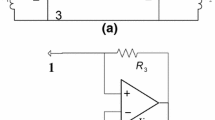Abstract
This paper deals with the mathematical modeling and bifurcation analysis of a class of semiconductor diode-based chaotic and hyperchaotic generators. The simple 4D hyperchaotic electronic oscillator introduced by Tamasevicius et al. (referred to as the TNC oscillator hereafter) is considered as a prototype/paradigm. In contrast to current approaches based on piecewise-linear methods, we propose a smooth mathematical model (with exponential nonlinearity) to investigate the dynamics of the oscillator. Various methods for detecting chaos including bifurcation diagrams, Lyapunov exponents, frequency spectra, and phase portraits are exploited to establish the connection between the system parameters and various complicated dynamics (e.g., hyperchaos, coexistence of attractors, and transient chaos) of the TNC oscillator. The transitions to hyperchaos are contrasted with equivalent scenarios obtained from an experimental implementation of the circuit. Using bifurcation diagrams as arguments, the analysis reveals/suggests that the Shockley diode model is appropriate for these types of circuits as it provides a close-form (i.e., accurate) description of the system’s dynamics and thus represents an interesting tool for design engineers.















Similar content being viewed by others
References
Tamasevicius, A., Namajunas, A., Cenys, A.: Simple 4D chaotic oscillator. Electron. Lett. 32(11), 957–958 (1996)
Tamasevicius, A., Cenys, A., Mykolaitis, G., Namajunas, A., Lindberg, E.: Hyperchaotic oscillators with gyrators. Electron. Lett. 33(7), 542–544 (1997)
Tamasevicius, A., Cenys, A.: Hyperchaos in dynamical systems with a monoactive degree of freedom. Chaos Solitons Fractals 9(1–2), 115–119 (1998)
Murali, K., Tamasevicius, A., Mykolaitis, G., Namajunas, A., Lindberg, E.: Hyperchaos system with unstable oscillators. Nonlinear Phenom. Complex Syst. 3, 7–10 (2000)
Barbara, C., Silvano, C.: Hyperchaotic behaviour of two bi-directionally Chua’s circuits. Int. J. Circuit Theory Appl. 30, 625–637 (2002)
Cenys, A., Tamasevicius, A., Baziliauskas, A., Krivickas, R., Lindberg, E.: Hyperchaos in coupled Colpitts oscillators. Chaos Solitons Fractals 17, 349–353 (2003)
Matsumoto, T., Chua, L.O., Kobayashi, K.: Hyperchaos: laboratory experiment and numerical confirmation. IEEE Trans. Circuits Syst. 11, 1143–1147 (1986)
Effati, S., Saberi Nik, H.: Hyperchaos control of the hyperchaotic chen system by optimal control design. Nonlinear Dyn. 73, 499–508 (2013)
Rossler, O.E.: An equation for hyperchaos. Phys. Lett. A 71, 155–157 (1979)
Keihui, S., Xuan, L., Cong, Z., Sprott, J.C.: Hyperchaos and hyperchaos control of the sinusoidally forced simplified Lorenz system. Nonlinear Dyn. 69, 1383–1391 (2012)
Mykolaitis, G., Tamasevicius, A., Cenys, A., Bumeliene, S., Anagnostopoulos, A.N., Kalkan, N.: Very high and ultrahigh frequency hyperchaotic oscillators with delay line. Chaos Solitons Fractals 17, 343–347 (2003)
Hanias, M.P., Giannaris, G., Spyridakis, A.: Rigas: time series analysis in chaotic diode resonator circuit. Chaos Solitons Fractals 27, 569–573 (2006)
Kengne, J., Chedjou, J.C., Kenne, G., Kyamakya, K.: Dynamical properties and chaos synchronization of improved Colpitts oscillators. Commun. Nonlinear Sci. Numer. Simul. 17, 2914–2923 (2012)
Kengne, J., Chedjou, J.C., Fono, V.A., Kyamakya, K.: On the analysis of bipolar transistor based chaotic circuits: case of a two-stage Colpitts oscillator. Nonlinear Dyn. 67, 1247–1260 (2012)
Maggio, G.M., Di Bernardo, M., Kennedy, M.P.: Nonsmooth bifurcations in a piecewise-linear model of the Colpitts oscillator. IEEE Trans. Circuits Syst. I 47, 1160–1177 (2000)
Ueta, T., Tamura, A.: Bifurcation analysis of a simple 3D oscillator and chaos synchronization of its coupled systems. Chaos Solitons Fractals 45, 1460–1468 (2012)
Maggio, G.M., De Feo, O., Kennedy, M.P.: Nonlinear analysis of the Colpitts oscillator and application to design. IEEE Trans. Circuits Syst. I 46, 1118–1130 (1999)
Damon, A.M., Grassi, G.: Experimental realization of observer-based hyperchaos synchronization. IEEE Trans. Circuits Syst. I 48(3), 366–374 (2001)
Tamasevicius, A., Mykolaitis, G., Cenys, A., Namajunas, A.: Synchronization of 4D hyperchaotic oscillators. Electron. Lett. 32(17), 1536–1538 (1996)
Tamasevicius, A., Cenys, A.: Synchronizing hyperchaos with a single variable. Phys. Rev. E 55(1), 297–299 (1997)
Cuomo, K.M., Oppenheim, A.V., Strogatz, S.H.: Synchronization of Lorenz-based chaotic circuits with applications to communications. IEEE Trans. Circuits Syst. 40(10), 626–633 (1993)
Tamasevicius, A., Cenys, A., Mykolaitis, G.: Driving nonlinear resonator with hyperchaotic signals. Electron. Lett. 32(22), 2029–2030 (1996)
Balanov, A., Janson, N., Postnov, D., Sosnovtseva, O.: Synchronization: From Simple to Complex. Springer, Berlin (2009)
Buscarino, A., Fortuna, L., Frasca, M.: Experimental robust synchronization of hyperchaotic circuits. Phys. D 238(18), 1917–1922 (2009)
Yang, T.: A survey of chaotic secure communication systems. Int. J. Comput. Cognit. 2(2), 81–130 (2004)
Guckenheimer, J., Holmes, P.: Nonlinear Oscillations, Dynamical Systems and Bifurcation of Vector Field. Springer, New York (1983)
Bennettin, G., Galgani, L., Strelcyn, J.M.: Kolgoromov entropy and numerical experiments. Phys. Rev. A 14, 2338–2345 (1993)
Masoller, C.: Coexistence of attractors in a laser diode with optical feedback from a large external cavity. Phys. Rev. A 50, 2569–2578 (1994)
Cushing, J.M., Henson, S.M., Blackburn, : Multiple mixed attractors in a competition model. J. Biol. Dyn. 1(4), 347–362 (2007)
Vaithianathan, V., Veijun, J.: Coexistence of four different attractors in a fundamental power system model. IEEE Trans. Circuits Syst. I 46(3), 405–409 (1999)
Buscarino, A., Fortuna, L., Frasca, M., Sciuto, G.: Chaos control in inductor-based chaotic oscillators. In: Proceedings of the 19\({{\rm th}}\) International Symposium on Mathematical Theory of Networks-MTNS2010, pp. 2207–2210. Budapest, Hungry, 5–9 July 2010
Paula, A.S., Savi, M.A., Peireira-Pinto, F.H.: Chaos and transient chaos in an experimental nonlinear pendulum. J. Sound Vib. 294, 585–595 (2006)
Izrailev, F.M., Timmermann, B., Timmermann, W.: Transient chaos in a generalized Henon map on the torus. Phys. Lett. A 126, 405–410 (1988)
Nayfeh, A.H.: Applied Nonlinear Dynamics: Analytical, Computational and Experimental Methods. Wiley, New York (1995)
Yang, X.S., Yuan, Q.: Chaos and transient chaos in simple Hopfield neural network. Neurocomputing 69, 232–241 (2005)
Yorke, J.A., Yorke, E.D.: The transition to sustained chaotic behavior in the Lorenz model. J. Stat. Phys. 21, 263–277 (1979)
Itoh, M.: Synthesis of electronic circuits for simulating nonlinear dynamics. Int. J. Bifurc. Chaos 11(3), 605–653 (2001)
Author information
Authors and Affiliations
Corresponding author
Rights and permissions
About this article
Cite this article
Kengne, J., Chedjou, J.C., Fonzin Fozin, T. et al. On the analysis of semiconductor diode-based chaotic and hyperchaotic generators—a case study. Nonlinear Dyn 77, 373–386 (2014). https://doi.org/10.1007/s11071-014-1301-9
Received:
Accepted:
Published:
Issue Date:
DOI: https://doi.org/10.1007/s11071-014-1301-9




